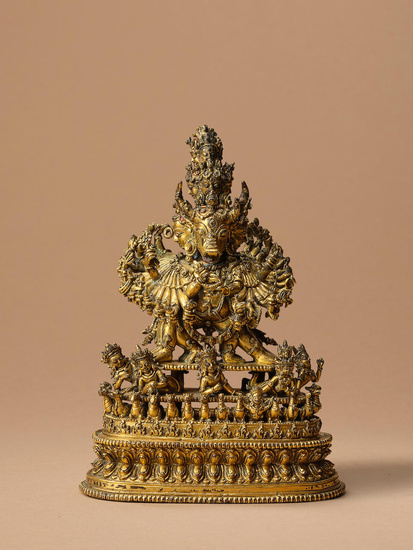STATUETTE DE VAJRABHAIRAVA EN ALLIAGE DU CUIVRE DORÉ NÉPAL, XVE...
STATUETTE DE VAJRABHAIRAVA EN ALLIAGE DU CUIVRE DORÉ
NÉPAL, XVE SIÈCLE
Himalayan Art Resources item no. 1823
14 cm (5 1/2 in.) high
A GILT COPPER ALLOY FIGURE OF VAJRABHAIRAVA
NEPAL, 15TH CENTURY
Published
Ulrich von Schroeder, Indo-Tibetan Bronzes, Hong Kong, 1981, p. 381, no. 102D.
Meinrad Maria Grewenig & Eberhard Rist (eds), Buddha: 2000 Years of Buddhist Art, 232 Masterpieces, Völklingen, 2016, p. 338, no. 142.
Exhibited
Buddha: 2000 Years of Buddhist Art, 232 Masterpieces, Völklingen, 24 June 2016 —19 February 2017.
Provenance
Christie's, London, 10 November 1976, lot 164
Philip Goldman, London
Sotheby's, New York, 21 March 2002, lot 61
Vajrabhairava arises as a tantric emanation of the Bodhisattva of Wisdom, Manjushri. Of Indic origin, his fearsome form derives from one of the avatars of Lord Shiva. He is represented with nine heads in three stacked tiers of which the main face features the head of a buffalo. His primary hands carry a skullcup and hooked knife in front of his chest. Thirty other hands encircle his torso, each holding an implement as well. Described as an archetype of fear itself, though an image of enlightened awareness, successful tantric meditation on Vajrabhairava promises to absorb and transmute one's understanding and experience of death (Henry Rice & Durham, Awaken, 2019, p. 116-9).
The small portable size of this figure limits no elaboration of its detail. Typical of Newari craftsmen, who served as itinerant artisans throughout Tibet, careful modelling illuminates the decadence of tightly-fitted details, as coincides with another of the subject (Christie's, New York, 20 March 2012, lot 112). Constructed in three parts - the lotus base, the intermediary tier of trampled gods, and the main figure - each component is rendered with minute and exacting detail. A slightly larger mirror example of the composition is held in the Victoria & Albert Museum, London (fig. 1; IM.173-1920). The extended platform of the lotus base lined with flame-like patterns references the Sun God Surya's charioteer drawn by seven horses on the left. Chandra, the Moon God, is depicted surrounded by animal representations of the other planetary deities on the right. The surmounting tier features Hindu gods with bodies, cast in full, awaiting to be crushed as Vajrabhairava spreads his weight across his floating stage overhead. The workmanship of the main figure, replete with deific ornamentation, including the beaded swags, severed-headed garland, and individualized implements, captures the deliberation of each detail. Given its diminutive size, this vividly cast portrayal of the tantric form reflects the legacy and technical precision for which metalworkers of the Kathmandu Valley are celebrated.
For the figures listed in this essay, please refer to our printed or digital catalogue.
銅鎏金大威德金剛像
尼泊爾 十五世紀
著錄
Ulrich von Schroeder,《Indo-Tibetan Bronzes》,1981年,頁381,編號102D
Meinrad Maria Grewenig 及 Eberhard Rist 編,《Buddha:2000 Years of Buddhist Art,232 Masterpieces》,弗爾克林根,2016年,頁338,編號142
展覽
「Buddha:2000 Years of Buddhist Art,232 Masterpieces」,弗爾克林根,2016年6月24日至2017年2月19日
來源
佳士得,倫敦,1976年11月10日,拍品164
Philip Goldman,倫敦
蘇富比,紐約,2002年3月21日,拍品61
大威德金剛為象徵智慧之文殊菩薩忿怒相。其駭人形象源自印度偉大濕婆神之化身之一。大威德金剛具有九面,列為三層,主面為牛。其主臂當胸,一手持嘎巴拉碗,一手持鉞刀。另三十手臂則各持法器,如光環繞其身軀。大威德金剛被描述為「怖畏」本身之象徵,然而亦是已開悟正覺之神祇,修行大威德金剛之秘法,成就修行者對死亡體悟之轉化、勝伏死主。
該像之尺寸小巧易攜,然而卻毫不影響其細節之精美,呈現紐瓦爾造像之典型風格。紐瓦爾人受藏人委託造像,成為流動的工坊,其活動遍布西藏各地。銅像精心鑄造之造型,體現出緊實的裝飾風格的衰退,與另一尊大威德金剛像(佳士得,紐約,2012年3月20日,拍品112)不謀而合。本尊造像由三個獨立部分構成:蓮花座、中層被踐踏之外神,以及主尊本身,而每部分皆被賦予細微而精準的細節。倫敦維多利亞與艾爾伯特博物館有一尊尺寸稍大、構造類似之造像(圖1,IM.173-1920)。蓮座向上延伸,托舉一排火焰,左側由七馬所拉之太陽神蘇利耶之戰車,右邊則為象徵其他行星神明之動物所簇擁之月亮神錢德拉。底座最上層為印度教諸神,鑄造以完整身形,即將遭受大威德金剛踩其頭頂浮台之重壓。大威德金剛周身滿綴昭示其神祇屬性之裝飾元素,如其層層珠串、頭顱長鍊以及屬其所用之法器,彰顯著工匠對每一細節的深思熟慮。體量如此之小像,卻栩栩如生地呈現此尊構造複雜之密宗神祇,展現出加德滿都河谷備受讚譽的金屬製造工匠的高超技藝與傳奇。
關於文中所提及之參考圖,請參閱此場拍賣之電子或紙質圖錄。
Bid on this lot
Estimate
Time, Location
Auction House
STATUETTE DE VAJRABHAIRAVA EN ALLIAGE DU CUIVRE DORÉ
NÉPAL, XVE SIÈCLE
Himalayan Art Resources item no. 1823
14 cm (5 1/2 in.) high
A GILT COPPER ALLOY FIGURE OF VAJRABHAIRAVA
NEPAL, 15TH CENTURY
Published
Ulrich von Schroeder, Indo-Tibetan Bronzes, Hong Kong, 1981, p. 381, no. 102D.
Meinrad Maria Grewenig & Eberhard Rist (eds), Buddha: 2000 Years of Buddhist Art, 232 Masterpieces, Völklingen, 2016, p. 338, no. 142.
Exhibited
Buddha: 2000 Years of Buddhist Art, 232 Masterpieces, Völklingen, 24 June 2016 —19 February 2017.
Provenance
Christie's, London, 10 November 1976, lot 164
Philip Goldman, London
Sotheby's, New York, 21 March 2002, lot 61
Vajrabhairava arises as a tantric emanation of the Bodhisattva of Wisdom, Manjushri. Of Indic origin, his fearsome form derives from one of the avatars of Lord Shiva. He is represented with nine heads in three stacked tiers of which the main face features the head of a buffalo. His primary hands carry a skullcup and hooked knife in front of his chest. Thirty other hands encircle his torso, each holding an implement as well. Described as an archetype of fear itself, though an image of enlightened awareness, successful tantric meditation on Vajrabhairava promises to absorb and transmute one's understanding and experience of death (Henry Rice & Durham, Awaken, 2019, p. 116-9).
The small portable size of this figure limits no elaboration of its detail. Typical of Newari craftsmen, who served as itinerant artisans throughout Tibet, careful modelling illuminates the decadence of tightly-fitted details, as coincides with another of the subject (Christie's, New York, 20 March 2012, lot 112). Constructed in three parts - the lotus base, the intermediary tier of trampled gods, and the main figure - each component is rendered with minute and exacting detail. A slightly larger mirror example of the composition is held in the Victoria & Albert Museum, London (fig. 1; IM.173-1920). The extended platform of the lotus base lined with flame-like patterns references the Sun God Surya's charioteer drawn by seven horses on the left. Chandra, the Moon God, is depicted surrounded by animal representations of the other planetary deities on the right. The surmounting tier features Hindu gods with bodies, cast in full, awaiting to be crushed as Vajrabhairava spreads his weight across his floating stage overhead. The workmanship of the main figure, replete with deific ornamentation, including the beaded swags, severed-headed garland, and individualized implements, captures the deliberation of each detail. Given its diminutive size, this vividly cast portrayal of the tantric form reflects the legacy and technical precision for which metalworkers of the Kathmandu Valley are celebrated.
For the figures listed in this essay, please refer to our printed or digital catalogue.
銅鎏金大威德金剛像
尼泊爾 十五世紀
著錄
Ulrich von Schroeder,《Indo-Tibetan Bronzes》,1981年,頁381,編號102D
Meinrad Maria Grewenig 及 Eberhard Rist 編,《Buddha:2000 Years of Buddhist Art,232 Masterpieces》,弗爾克林根,2016年,頁338,編號142
展覽
「Buddha:2000 Years of Buddhist Art,232 Masterpieces」,弗爾克林根,2016年6月24日至2017年2月19日
來源
佳士得,倫敦,1976年11月10日,拍品164
Philip Goldman,倫敦
蘇富比,紐約,2002年3月21日,拍品61
大威德金剛為象徵智慧之文殊菩薩忿怒相。其駭人形象源自印度偉大濕婆神之化身之一。大威德金剛具有九面,列為三層,主面為牛。其主臂當胸,一手持嘎巴拉碗,一手持鉞刀。另三十手臂則各持法器,如光環繞其身軀。大威德金剛被描述為「怖畏」本身之象徵,然而亦是已開悟正覺之神祇,修行大威德金剛之秘法,成就修行者對死亡體悟之轉化、勝伏死主。
該像之尺寸小巧易攜,然而卻毫不影響其細節之精美,呈現紐瓦爾造像之典型風格。紐瓦爾人受藏人委託造像,成為流動的工坊,其活動遍布西藏各地。銅像精心鑄造之造型,體現出緊實的裝飾風格的衰退,與另一尊大威德金剛像(佳士得,紐約,2012年3月20日,拍品112)不謀而合。本尊造像由三個獨立部分構成:蓮花座、中層被踐踏之外神,以及主尊本身,而每部分皆被賦予細微而精準的細節。倫敦維多利亞與艾爾伯特博物館有一尊尺寸稍大、構造類似之造像(圖1,IM.173-1920)。蓮座向上延伸,托舉一排火焰,左側由七馬所拉之太陽神蘇利耶之戰車,右邊則為象徵其他行星神明之動物所簇擁之月亮神錢德拉。底座最上層為印度教諸神,鑄造以完整身形,即將遭受大威德金剛踩其頭頂浮台之重壓。大威德金剛周身滿綴昭示其神祇屬性之裝飾元素,如其層層珠串、頭顱長鍊以及屬其所用之法器,彰顯著工匠對每一細節的深思熟慮。體量如此之小像,卻栩栩如生地呈現此尊構造複雜之密宗神祇,展現出加德滿都河谷備受讚譽的金屬製造工匠的高超技藝與傳奇。
關於文中所提及之參考圖,請參閱此場拍賣之電子或紙質圖錄。



